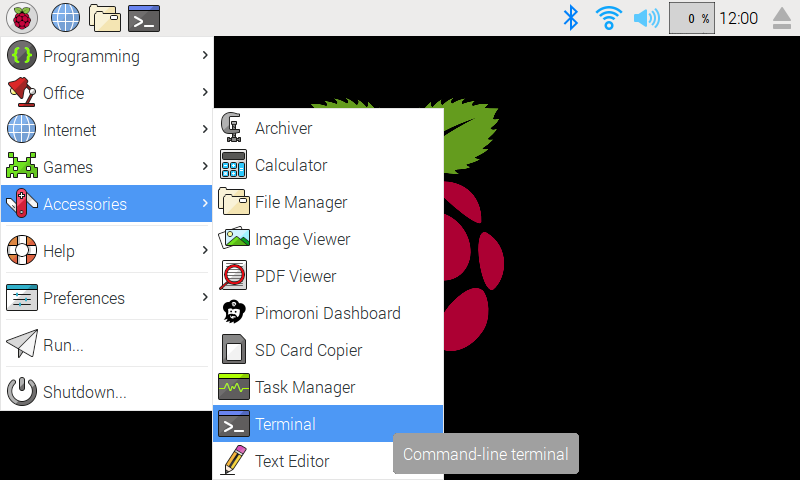https://shop.pimoroni.com/products/enviro-phat
The Pimoroni Enviro pHAT boast a plethora of sensors and connectivity for measuring your environment.
Enviro pHAT includes:
- An LSM303D accelerometer/magnetometer for detecting orientation, motion and heading
- A BMP280 temperature/pressure sensor
- A TCS3472 colour sensor, for detecting the amount and colour of light
- An ADS1015 analog sensor with four 3.3v tolerant channels for your external sensors
- A 5v power supply pin for powering your sensors, which you can regulate or divide to 3v if needed
- Two LEDs connected to GPIO #4 for illuminating objects over the colour sensor
We've created an easy installation script that will install all pre-requisites and get your Enviro pHAT up and running with minimal efforts. To run it, fire up Terminal which you'll find in Menu -> Accessories -> Terminal on your Raspberry Pi desktop, as illustrated below:
In the new terminal window type the command exactly as it appears below (check for typos) and follow the on-screen instructions:
curl https://get.pimoroni.com/envirophat | bashAlternatively, on Raspbian, you can download the pimoroni-dashboard and install your product by browsing to the relevant entry:
sudo apt-get install pimoroni(you will find the Dashboard under 'Accessories' too, in the Pi menu - or just run pimoroni-dashboard at the command line)
If you choose to download examples you'll find them in /home/pi/Pimoroni/envirophat/.
on Raspbian:
sudo apt-get install python3-envirophatother environments:
sudo pip3 install envirophaton Raspbian:
sudo apt-get install python-envirophatother environments:
sudo pip2 install envirophatIf you want to contribute, or like living on the edge of your seat by having the latest code, you should clone this repository, cd to the library directory, and run:
sudo python3 setup.py install(or sudo python setup.py install whichever your primary Python environment may be)
In all cases you will have to enable the i2c bus.
- Guides and tutorials - https://learn.pimoroni.com/enviro-phat
- Function reference - http://docs.pimoroni.com/envirophat/
- GPIO Pinout - https://pinout.xyz/pinout/enviro_phat
- Get help - http://forums.pimoroni.com/c/support
